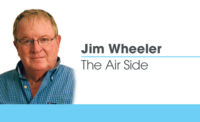Jim Wheeler: Next refrigerant phase-out by 2023?

Yes, it’s happening again and almost nobody is really prepared! And yes, the general public is once more going to have to pay the bill. What am I talking about?
Well, while attending the AHR Expo in Atlanta in January, I was told the state of California has passed legislation requiring the phase-out of what most of us thought to be the “environmentally-friendly” refrigerants (R-410a, R-134, etc.) by the year 2023, because of the “high global warming potential (GWP)” of these refrigerants. And if HVACR manufacturers have to change the refrigerants to satisfy the state of California, they likely will have to change the refrigerants in all the equipment they sell throughout the entire United States and elsewhere, since it makes no sense for these companies to manufacture two different types of equipment lines.
Note that I said “almost” nobody is prepared for this, because Carrier Corp. announced at the show that it will, in fact, be ready to change over its residential equipment line from the use of R410a to a new “low-GWP” refrigerant that it calls “Puron Advanced (R-454B),” which I am told will be manufactured for Carrier by Chemours. However, most other equipment manufacturers I spoke to about this were less sure about what they will do, and almost all are taking a “wait-and-see” approach.
Also, at this year’s AHR Expo, Honeywell announced it will be producing a new “low-GWP” refrigerant for use in residential A/C equipment that will be a contender to Carrier’s refrigerant. Honeywell calls it “Solstice N41.” And it pointed out that its refrigerant is nonflammable, which is important because the Carrier refrigerant is said to be “mildly flammable,” and most local building codes will have to be changed to allow the use of any flammable refrigerants, mild or otherwise.
Of course, Daikin has been promoting (and actually using in Japan and in Europe) another “low-GWP” refrigerant, R-32 (CH2F2), which also is mildly flammable. So, I spoke to some of the folks at Daikin and asked whether they are ready to support R-32 as the third contender for the U.S. residential market replacement? The person I spoke to waffled a bit.
However, one of the many manufacturers I talked to about this at the show suggested that we may actually see two different refrigerants used in residential equipment. Which two will it be? Well, consider the choices:
-
Carrier already has announced it will use R-454B, so it is sure. However, it is mildly flammable, so codes will have to be changed.
-
Honeywell’s “Solstice N41” is nonflammable, so local codes won’t have to be changed. But like Carrier’s option, it is a blend and it will likely carry a higher price.
-
R-32 also is mildly flammable, but it is relatively inexpensive to produce. The only drawback that compressor manufacturers mentioned is that it does have a high discharge temperature, which may or may not prove to be a real problem in actual use. And of course, there is less profit margin in it (wink wink).
Either way, it looks like we may be using at least one mildly-flammable refrigerant in the future, and if so, the systems likely will require some sort of leak detection to satisfy both consumers and codes that a leak, large or small, won’t create a fire hazard.
Also note that (as is true of R-410a in R-22 systems) none of the above refrigerants can be substituted for use in R-410a systems, which means we will continue to deal with the problem of unqualified service people mixing dissimilar refrigerants to the detriment of compressors and operating efficiencies. And as today, we likely will see the same phase-outs and shortages that we’ve experienced with R-22.
Looking for a reprint of this article?
From high-res PDFs to custom plaques, order your copy today!




